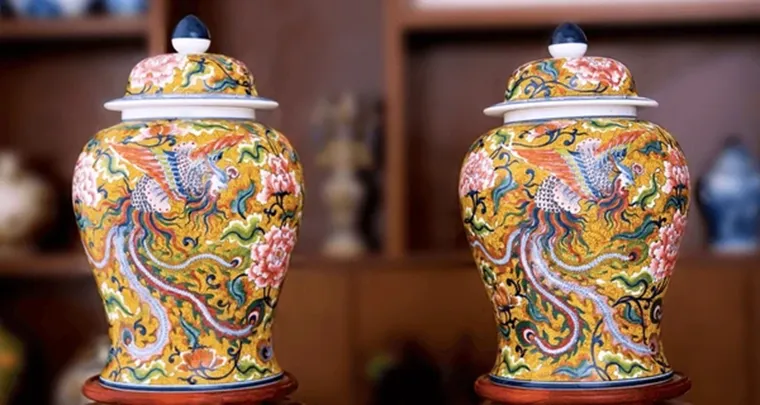Bat Trang Pottery Village: The Timeless Craftsmanship of Vietnam
Nestled along the Red River, just 15 kilometers from Hanoi, Bat Trang Pottery Village is a must-visit destination for those interested in Vietnamese culture, traditional craftsmanship, and authentic ceramic art. With a history spanning over 700 years, this village is the oldest and most famous pottery-making hub in Vietnam, producing high-quality ceramics that are exported worldwide.
A trip to Bat Trang allows visitors to witness skilled artisans at work, explore centuries-old kilns, and even try their hand at pottery-making. Whether you're looking for unique souvenirs, artistic inspiration, or an immersive cultural experience, Bat Trang offers something special for every traveler.
1. The Rich History of Bat Trang Pottery Village
1.1. Origins and Development
The origins of Bat Trang Pottery Village date back to the 14th century, during the Ly Dynasty. Legend has it that the village was founded by a group of highly skilled potters who settled here due to the abundance of white clay—a crucial material for high-quality ceramics. Over the centuries, the village became renowned for its innovative techniques and exquisite designs, supplying ceramics to royal families, temples, and merchants across Vietnam and beyond.
1.2. Bat Trang Ceramics Through the Ages
-
Feudal Era: Used in imperial courts, pagodas, and temples, Bat Trang ceramics were highly prized for their intricate blue-and-white patterns.
-
French Colonial Period: The village adapted by producing Western-style ceramics, blending European influences with Vietnamese craftsmanship.
-
Modern Era: Today, Bat Trang is not only a historical landmark but also a center for both traditional and contemporary ceramic art, exporting its products globally.

Bat Trang ceramic village is a traditional craft hub renowned for its centuries-old history of producing exquisite pottery. - Photo source: Shutterstock
2. What Makes Bat Trang Ceramics Special?
Bat Trang ceramics are distinguished by their high-quality craftsmanship, unique designs, and durability. The artisans use locally sourced white clay, which is fine-grained and heat-resistant, making it ideal for pottery. Some of the most famous ceramic styles from Bat Trang include:
2.1. Blue and White Porcelain (Gốm Hoa Lam)
This classic style features delicate blue patterns on a white ceramic base, often depicting dragons, phoenixes, or traditional landscapes. These pieces are commonly used in temples, altars, and Vietnamese households.
2.2. Celadon Ceramics (Gốm Men Ngọc Bích)
Recognized by their smooth, greenish glaze, celadon ceramics were once reserved for the royal family. The glaze not only enhances beauty but also prevents cracking and increases durability.
2.3. Crackled Glaze Pottery (Gốm Men Rạn)
A distinctive style featuring a crackled texture, often combined with bronze embellishments. These pieces are popular for tea sets, vases, and religious artifacts.
2.4. Hand-Painted and Modern Designs
Today, many artisans experiment with colors, shapes, and textures, creating contemporary ceramic art that blends traditional techniques with modern aesthetics.

The exceptional quality, unique designs, and durability make Bat Trang ceramics highly regarded. - Photo Source: Shutterstock
3. Exploring Bat Trang Pottery Village
Visiting Bat Trang Pottery Village is like stepping into a living museum of craftsmanship. The village is filled with workshops, markets, and ancient kilns, allowing visitors to fully immerse themselves in Vietnam’s pottery-making traditions.
3.1. Bat Trang Pottery Market
One of the highlights of Bat Trang is its bustling pottery market, where visitors can browse thousands of ceramic products, including:
-
Bowls, plates, and teapots
-
Decorative vases and sculptures
-
Custom-made ceramic artworks
Many shops allow visitors to negotiate prices, making it a great place to find unique, high-quality souvenirs at reasonable prices.
3.2. Try Your Hand at Pottery-Making
One of the most exciting activities in Bat Trang is the hands-on pottery-making experience. Many workshops offer:
-
Wheel-throwing sessions, where you can shape your own pottery piece.
-
Hand-painting workshops, allowing you to personalize your ceramic creations.
-
Firing and glazing demonstrations, showing how raw clay is transformed into finished pottery.
This interactive experience is perfect for families, couples, and art enthusiasts looking to connect with Vietnamese heritage in a fun and creative way.
3.3. Explore the Ancient Kilns and Artisan Houses
Bat Trang is home to centuries-old kilns, where artisans have been firing pottery for generations. Walking through the village, you can visit:
-
Traditional wood-fired kilns, which produce unique textures and colors.
-
Family-owned workshops, where pottery-making skills have been passed down for centuries.
-
The Bat Trang Museum, showcasing historical ceramic pieces and modern innovations.
To further enrich your understanding of Hanoi's past, consider also exploring the old city gate.
4. How to Get to Bat Trang Pottery Village
Whether you're coming directly from Noi Bai International Airport or from within Hanoi, here are some common ways to travel to Bat Trang Pottery Village:
4.1. By Bus
Take Bus 47 from Long Bien Bus Station in Hanoi. The ride takes about 30-40 minutes and costs only 7,000 VND (~$0.30 USD).
4.2. By Motorbike or Taxi
A motorbike ride from Hanoi takes 20-30 minutes. Taxi or Grab services are available for 200,000 - 300,000 VND (~$8 - $12 USD) round-trip.

Visitors can quickly reach Bat Trang ceramic village by taking a taxi. - Photo source: Pexels
5. Best Time to Visit Bat Trang Pottery Village
Spring (March - April) and Autumn (September - November) offer the most pleasant weather for exploring the village. Avoid visiting during midday in summer (June - August) as it can get very hot and humid. Weekends are busiest, so visit on a weekday morning for a more relaxed experience.
6. Nearby Attractions
If you’re visiting Bat Trang Pottery Village, consider exploring these nearby sites:
-
Dong Ho Painting Village – Famous for its traditional folk paintings, located 1 hour away.
-
But Thap Pagoda – A stunning Buddhist temple known for its intricate carvings and architecture.
-
Long Bien Bridge – A historic bridge offering scenic views of the Red River.
For those interested in Hanoi's cultural landmarks, a visit to the opera house hanoi in the city center is also highly recommended.
For art lovers, culture seekers, and curious travelers, Bat Trang Pottery Village provides an enriching and unforgettable immersion into Vietnam's artistic heritage. Beyond shopping for unique handmade ceramics, visitors can engage in pottery making or simply absorb the village's traditional charm, making Bat Trang a compelling must-visit when exploring northern Vietnam. The scent of firing clay and the sight of skilled artisans at work create a truly unique atmosphere.
|
Joytime - Your Vietnam Journey's Servant Expert Follow us for travel tips, local insights, and exclusive offers:
|

Danish Nguyen
Danish Nguyen is a renowned travel blogger in Vietnam with over 5 years of experience sharing unique travel experiences. With a passion for exploring new places, Danish captures incredible moments and provides readers with valuable tips to discover the beauty of his homeland.


















